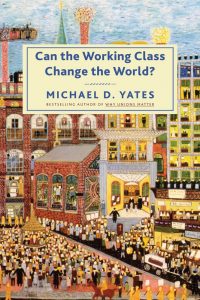Can the Working Class Change the World?
218 pp, $19 pbk, ISBN 978-1-58367-710-0
By Michael Yates
Reviewed by Ed Ford for Dollars & Sense, May/June 2020
“Well, can it? Michael Yates, a long-time member of the Monthly Review Press editorial staff and a frequent contributor to Monthly Review, attempts to answer that question. The result is a brief (just over 200 pages) but comprehensive response—and the answer turns out to be ‘Yes.’
Yates begins with a detailed description of the world-wide working class. Who they are: most wage laborers, the reserve army of labor (unemployed, involuntary part-timers and discouraged workers), unpaid reproductive workers, and most peasants and laborers. How many: several billion spread across the globe. According to Yates, there are more people in the working class than many might suppose.
The book provides a helpful overview of Marxist theory, including an explanation of capitalist accumulation, in which workers generate a surplus over and above their wages (and other costs), allowing capitalists to reap profits. Class struggle between labor and capital influences the split between wages and profits. Capital’s hand is enhanced by the size of the reserve army of the unemployed, through deskilling, substitution of capital for labor, and the availability of lower-cost labor elsewhere. Expropriation was initially made possible by conquest, slavery, and robbery.
While critical institutions (such as the state, schools, and media) may affect results, capital dominates. The rise of capitalism made wage labor the primary form of work. From the start, barriers to working-class unity developed (skilled vs. unskilled, deskilling, alienation, capital mobility, colonialism, imperialism, racism, patriarchy, divide and rule, health destruction). But workers have contested capital’s power through a variety of means, including marches, picketing, and strikes. Labor unions have raised the wages and benefits of both union and non-union workers. Where union density is high, labor parties have been able to increase social welfare benefits. But the power of capital remains intact. The collapse of the socialist bloc (especially China and the Soviet Union), along with the scourge of neoliberalism and the decline of social democracies across the globe, have undermined unions and labor parties.
In the final chapter of the book, Yates suggests three main ways that the working class can, indeed, change the world: 1) creating a positive and radical working-class program that includes demands for economic, racial, and environmental justice, 2) harnessing the rank-and-file strategy to make unions more democratic and recruit new union leaders, and 3) creating independent, working-class parties.
In this time of world-wide health and economic crisis this overview of the past, present, and possible future of the working class is certainly a stimulating read.”
—EF
[Ed Ford, Professor Emeritus, University of South Florida]
Copyright Dollars & Sense, reprinted with permission


Comments are closed.